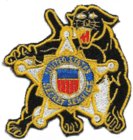Secret Service Counter-Assault Teams
| Counter-Assault Teams | |
|---|---|
| Abbreviation | CAT |
|
Patch of the Counter-Assault Teams | |
| Agency overview | |
| Formed | 1979 |
| Legal personality | Governmental: Government agency |
| Jurisdictional structure | |
| General nature |
|
| Operational structure | |
| Parent agency |
|
Secret Service Counter-Assault Teams (CAT) are tactical forces maintained by the U.S. Secret Service which are responsible for repelling coordinated attacks against dignitaries. This is in contrast to a close protection team whose mission is to shield a dignitary from attackers and evacuate them to a place of safety. The Secret Service first began fielding counter-assault teams in 1979. "Hawkeye Renegade" is the designation for a CAT assigned to the President of the United States.
History
Prior to 1979, Secret Service vehicle convoys for VIPs in high-risk situations included a large sedan known as the "muscle car" in which five or six Secret Service special agents armed with submachine guns rode. The "muscle car" team was an ad hoc contingent drawn from special agents working at a local Secret Service office, as opposed to those regularly assigned to protective duties. They were instructed, in the event of an attack against the convoy, to lay-down a barrage of suppressive fire against the source of the attack so as to allow the dignitary's vehicle the opportunity to escape without being pursued or blockaded.[1][2][3]
In 1979 the Secret Service formalized the counter-assault team program with permanently assigned, specially trained operators.[1][2][3]
Hawkeye Renegade
Following the attempted assassination of Ronald Reagan, a CAT that came to-be designated "Hawkeye Renegade" was assigned to full-time presidential escort duty. According to Dan Bongino, Hawkeye Renegade has never responded to an actual armed attack.[4][1][3]
Special agents assigned to Hawkeye Renegade were implicated in the Summit of the Americas prostitution scandal in 2012.[5]
Operations
Selection and training
Members of counter-assault teams are Secret Service special agents who have completed an initial, eight-month, course at the Federal Law Enforcement Training Center in Glynco, Georgia and have successfully served at least several years in the Secret Service. Upon selection, CAT operators undergo an additional seven weeks of specialized training that includes counter-ambush tactics and close quarters combat. Applications for the team are competitive and physical requirements for entry include three pull-ups wearing a 45-pound (20 kg) weighted vest and a 1.5-mile (2.4 km) run in under nine minutes. Approximately ten-percent of applicants are ultimately selected.[4][6]

Equipment
Typically, CAT members deploy in black battle dress uniforms. Each member not otherwise assigned a heavier weapon is equipped with a SR-16 rifle, a Sig Sauer P229 pistol, and M84 stun grenades.[4][2]
According to some reports, presidential motorcades also include a vehicle sheltering an M134 minigun in a pop-up turret as a last line of defense against assailants who cannot be stopped by any other means.[7][8][9]
Duties
CATs operate both as part of mobile convoys and in fixed locations. In the event a protected dignitary, the dignitary's vehicle, or a building housing a dignitary, is attacked by multiple assailants, a CAT is responsible for engaging and diverting the attackers, thereby buying the close protection team time to evacuate the dignitary to a safe area.[4]
Hawkeye Renegade, when operating as part of a U.S. president's motorcade, travels in a vehicle several car lengths behind the presidential state car.[10]
See also
References
- 1 2 3 Emmett, Dan (2014). Within Arm's Length: A Secret Service Agent's Definitive Inside Account of Protecting the President. Macmillan. pp. 102–110. ISBN 1250044715.
- 1 2 3 Kessler, Ronald (2014). The First Family Detail: Secret Service Agents Reveal the Hidden Lives of the Presidents. Crown. ISBN 0804139229.
- 1 2 3 Kessler, Ronald (2009). In the President's Secret Service. Crown. pp. 65–68. ISBN 0307461378.
- 1 2 3 4 Nakamura, David (27 March 2014). "Everything you need to know about CAT, the Secret Service's baddest bad boys". Washington Post. Retrieved 27 November 2016.
- ↑ Ambinder, Marc (26 March 2014). "The Secret Service has a drinking problem". The Week. Retrieved 28 November 2016.
- ↑ "JJRTC - James J. Rowley Training Center". secretservice.gov. U.S. Secret Service. Retrieved 28 November 2016.
- ↑ Aldrich, Richard (2016). The Black Door: Spies, Secret Intelligence and British Prime Ministers. HarperCollins. ISBN 0007555458.
- ↑ Borroz, Tony (20 January 2009). "Presidential Motorcade Packs Serious Firepower". WIRED. Retrieved 28 November 2016.
- ↑ White, Charlie (16 August 2007). "Presidential SUV Machine Gun Pops Up, Fills the Air With Lead". Gizmodo. Retrieved 28 November 2016.
- ↑ "The Presidential Motorcade". The Atlantic. 8 February 2011. Retrieved 28 November 2016.
